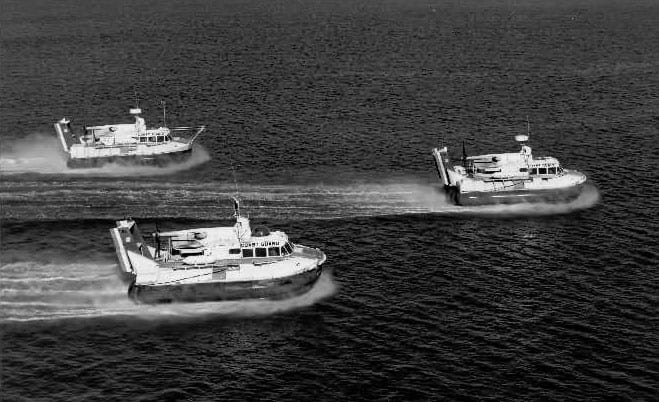 In the late 1960s significant interest was generated within the Coast Guard as to the feasibility of obtaining Air Cushion Vehicles (ACVs) to support a variety of Coast Guard missions. When three SK-5 ACVs, no longer required for the naval mission in Vietnam, became available in late 1969 the Coast Guard elected to conduct an expanded ACV evaluation program. The hovercraft were overhauled in the summer of 1970. Two ACVs, the first arriving in October of 1970 were assigned to the Fort Point Coast Guard Station, San Francisco, California. The third was utilized for Arctic Trials at Point Barrow Alaska.
In the late 1960s significant interest was generated within the Coast Guard as to the feasibility of obtaining Air Cushion Vehicles (ACVs) to support a variety of Coast Guard missions. When three SK-5 ACVs, no longer required for the naval mission in Vietnam, became available in late 1969 the Coast Guard elected to conduct an expanded ACV evaluation program. The hovercraft were overhauled in the summer of 1970. Two ACVs, the first arriving in October of 1970 were assigned to the Fort Point Coast Guard Station, San Francisco, California. The third was utilized for Arctic Trials at Point Barrow Alaska.
The SK-5 was 38 feet 10 inches long with a beam of 23 feet 9 inches and was 15 feet 11 inches in height. The cabin supported a crew of three consisting of an Operator, Radar/Navigator, and a SAR crewman. The SK-5 could comfortably carry six passengers or an appropriate amount of cargo. The craft had a maximum speed of 70 knots and a range of 300 nautical miles. It was powered by a General Electric LM100 Marine Gas Turbine rated at 1050 shaft horsepower. A four-bladed, variable pitch aviation propeller provided thrust and seven foot diameter centrifugal supplied the air cushion. Both fan and propeller were driven off the same engine.
The operational evaluation program at Fort Point commenced January 1, 1971 under the direction of Commander Thomas C. Lutton, USCG. During the next eight months, 1,400 hours of formal operational evaluation was conducted to determine the ACVs capabilities in Search and Rescue, Law enforcement, Aids to Navigation, Marine Safety and Logistics. The ACV proved to be uniquely functional in many types of Search and Rescue Missions. The hovercraft, in company with aircraft and small surface vessels provided an efficient and highly effective response team. The ACV, utilized in law enforcement, provided a means of high speed pursuit, not available with small surface craft, making evasion extremely difficult. In Aids to Navigation missions, the ACV proved capable of performing all routine servicing operations in much less time than previously required. A larger ACV, however, would be required to lift or move an aid. Logistics was accomplished within a much reduced timeframe but was limited by size of the ACV.
In October of 1970, The Naval Ship Research and Development Center acting as an agent for the Department of Defense, requested the Coast Guard provide the operating and maintenance personnel for an ACV to be operated from the Naval Arctic Research Laboratory, Point Barrow, Alaska. The ACV was used in a series of performance tests over the snow and ice on the lagoon east of Barrow. As summer progressed additional tests over tundra and open water were conducted. On 1 August the craft departed Barrow to operate in conjunction with the Coast Guard Icebreaker Northwind. The ACV followed the pack line in a westerly direction and then turned north, engaging the major pack ice in route to the base camp. The hovercraft was used to transfer personnel and supplies between the base camp and the Northwind. It was also fitted with sounding equipment and an electric winch to conduct observation probes. The Consensus was that the ACV performed far better than anticipated and would be of significant use but could not replace the shipboard helicopters.
On completion of the Arctic trials the ACV was transported to Traverse City, Michigan and commenced winter operations out of the Saint Ignace Coast Guard Station. Although the northern operation pointed out several problem areas the potential of this type of vehicle in the Northern Great Lakes became obvious. Additional evaluation was later conducted in the Chesapeake Bay Area. The San Francisco unit continued to operate during this period.
The evaluation report recognized that the ACV would not replace the utilization of boats and aircraft due to some operational limitations the ACV had that were not present in the other craft. The report did, however, conclude that the air cushion vehicle could and should play a significant role in the Coast Guard. It went on to illustrate that used in concert with small boats and aircraft, the Coast Guard would be able to provide a more effective response capability at less cost.
The Coast Guard did not procure ACVs. The capability was not disputed but it was recognized that newer and more advanced and more expensive hovercraft would have to be procured. The Coast Guard was in the process of a large upgrade of its small craft and cutters as well as significant aircraft purchases and the development of the infrastructure required to operate them. The determining factor was the amount of money available and project priority. Recognizing that the ACV could not replace the aircraft or small boat the Coast Guard elected not to utilize ACVs.
